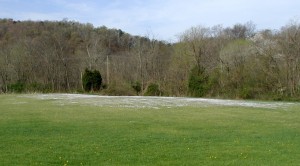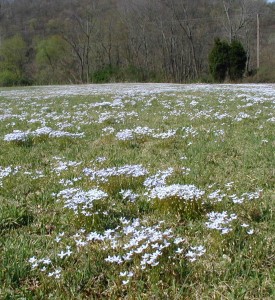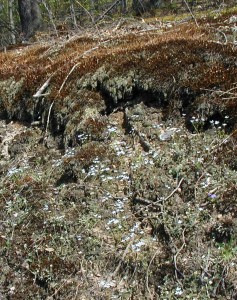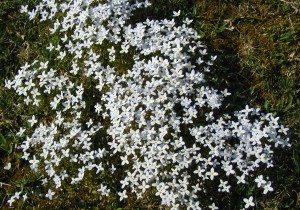A dainty little flower that can truly be appreciated from afar is called Bluets, Houstonia caerulea. You never see just one Bluet, so I guess that’s why they’re called Bluets.
Bluets are perennials that have the ability to form large colonies. It is this ability that will probably draw your attention to this tiny little plant.

Light blue flowers form a great big colony in the field in the image above. The flowers stand taller than the surrounding grass, which was very short, and so appeared as a great big patch of light blue color in the field.

Open areas, grassy fields and yards are likely areas to find Bluets, but they can occur in other open areas. Below, a small group of Bluets were found growing on a wooded bank along a country road.

The white spots in the image above are bluets that were growing on a hill that faced the morning sun. (Photo taken 13Apr2010. All other photos taken 7Apr2010.)
Four-petaled flowers are held upright on a thin stem, 2 to 8 inches high. Light blue to white petals surround a yellow ring in the center of the flower. Petals are pointed and the flowers look rather symmetrical.

Leaves are smaller than the blossoms. Very thin and short, the leaves are paired on the flower stems which have a few larger basal leaves.
The Houstonia genus is represented by 20 species in our area, but distinguishing them requires examination of the flowers, fruit and seed shape. Microscopy must be used to see fine seed detail in order to identify Bluets to the species level. Exact identification would require collection of fruits and seeds and further examination. In general, we can just refer to these cute little flowers as Bluets.
According to Peterson’s Medicinal Plants Guide Native Americans used a leaf tea for bed-wetting. No other use is mentioned and apparently Bluets aren’t edible, so I guess we’ll just have to appreciate the little Bluets smiling in the millions from afar.
![Reblog this post [with Zemanta]](http://img.zemanta.com/reblog_e.png?x-id=538d809d-4f79-4097-97a0-a12b660553fe)
1 thought on “Bluets Colonize the Open Field”